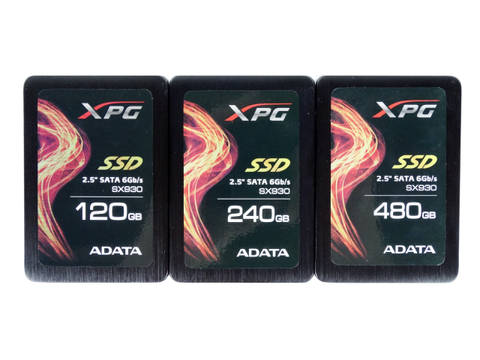Early Verdict
Flash enhancements for aging 2D technology are still not able to fill the gap between Samsung V-NAND and everything else. A lot of money is going into controller development to keep 15nm/16nm 2D flash viable until IMFT and Flash Forward's 3D roll-out. If a company wants to compete with Samsung and sell SSDs it needs something different. Low cost NVMe is about the only untapped frontier left. Everything else is just moving backwards.
Pros
- +
Adata's accessory package is comparable to the best on the market today. The SX930 also uses enhanced MLC+ flash that is new and exciting.
Cons
- -
MLC+ is mainly just a way to compete with Samsung's superior flash before the 3D ramp up begins for Micron. The SX930 price is not competitive enough to be a real option for gamers or other targeted user group.
Why you can trust Tom's Hardware
Introduction
Adata's XPG SX family is the company's flagship. It recently updated the line-up with a new XPG SX930 that emphasizes endurance rather than performance.
This is the first time I can remember that an SSD vendor shifted the focus of its top-tier product from speed to endurance. For most users, endurance is an afterthought; most enthusiasts are looking for big performance results, even though the numbers given are almost always irrelevant. As the technology used to manufacture NAND inches closer to single-digit atom insulators, endurance is back in vogue as an SSD selling point.
All indications point to 15/16nm as the final node for 2D flash lithography. The next step is stacked cells, in which density increases come from more layers per die rather than trying to fit the same capacity in a smaller area. With each shrink, the insulator layer, which is vulnerable to wear, gets smaller. This decreases the number of times that a cell can write bits and effectively hold them for a long period of time. NAND makers have developed several innovative ways to combat this issue. One method is to reduce the voltage used to charge the cells. In order to do that, the charge has to be applied for a longer time, thus increasing write latency. We often refer to this method as eMLC flash. It has been around for a long time, and is commonly used in the SSDs aimed at enterprise customers.
Flash branded as MLC+ writes to a section of the MLC die in single-level cell mode. SLC is very easy to read and write; the charge is either on or off. This allows the program or read operation to be a little sloppy compared to MLC or TLC, where accuracy is more important. Random write operations wear out flash faster than sequential operations. The sloppy SLC area catches random write data and passes it along to the MLC area as sequential writes. Since the SLC area needs to retain data for only a short period of time, retention is not a problem.
Over the last year, we've all read reports about SSD endurance, with total bytes written (TBW) reaching numbers well beyond manufacturer ratings. What most of these stories fail to take into account is how long information is retained after the drive is without power. Turned on and under constant use, a SSD may move a massive amount of data, but what good is the drive if it shuts down and data is lost a few days later? Proper endurance testing isn't just about how many bytes you can write to an SSD before it fails. At some point, you need to think about how long the data can be reliably suspended in the gates.
With MLC+, endurance works in the opposite direction. The cache doesn't need to hold information; it's only touched for a brief time. When reading and writing a single bit, operational latency is lower. As odd as it sounds, this increases a product's overall performance and endurance.


